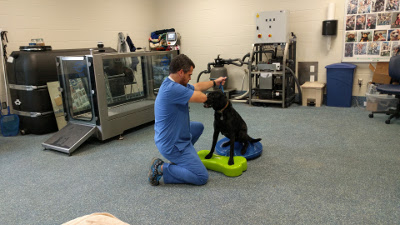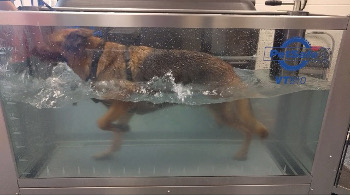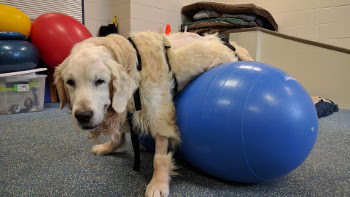Veterinary Physical Rehabilitation
 Long Animal Hospital has invested in a state of the art Canine Physical Rehabilitation Center for the well being of our patients. Located on our lower floor, the room includes a soft non-slip flooring, an underwater treadmill, therapeutic exercise equipment, class 4 medical laser, therapeutic ultrasound, electrical stimulation unit, cavaletti rails and built in stairs with a ramp. Dr. Brian Killough is a certified canine rehabilitation practitioner through the University of Tennessee’s Canine Rehabilitation Certificate Program (C.C.R.P.). Just as human physical therapist allow their patients to recover more quickly and completely, so to will Long Animal Hospital help our patients.
Long Animal Hospital has invested in a state of the art Canine Physical Rehabilitation Center for the well being of our patients. Located on our lower floor, the room includes a soft non-slip flooring, an underwater treadmill, therapeutic exercise equipment, class 4 medical laser, therapeutic ultrasound, electrical stimulation unit, cavaletti rails and built in stairs with a ramp. Dr. Brian Killough is a certified canine rehabilitation practitioner through the University of Tennessee’s Canine Rehabilitation Certificate Program (C.C.R.P.). Just as human physical therapist allow their patients to recover more quickly and completely, so to will Long Animal Hospital help our patients.
There are numerous patients who can benefit from canine rehabilitation.
Post surgical
As an example, a common injury for our canine patients is a cranial cruciate rupture or ACL. From the moment the leg is injured, the patient will shift weight off the leg. Over time, the patient can lose up to 1⁄3 of their muscle mass in the affected leg. Even with proper surgical repair, the leg may never regain full use without rehabilitation. This not only decreases the leg’s function, but also places unnatural forces on the opposite leg, the front limbs and the spine. Therefore an injury to one leg can affect the function of other areas and cause unwanted pain. In the human model, a post surgical patient is placed in a machine that puts the operated leg through range of motion exercises immediately post-op. Obviously we can’t place our patients in a machine, but we have numerous exercises including the underwater treadmill and treatment modalities that work the affected leg to regain better function and more importantly control pain.
Post trauma/injury
Certain traumas or injuries may not require surgical intervention. However, careful and controlled rehabilitation may be warranted to return the patient to full function without further damage to the injured area.
Spinal pain
Spinal pain is a common problem with our canine patients. Often patients can have a bulging disc in their spine or just chronic arthritis. Once again, pain from one area can affect other joints and muscle layers. Think of someone you know with neck pain. More often than not, most of the pain occurs within muscle layers running down the neck and shoulders. If you can relieve that pain, the patient will feel better and recover more quickly.
Degenerative myelopathy
This is a fairly common problem for many large breed patients. This condition causes demyelination of the nerves starting with the hind-limbs and causes progressive, severe hind limb weakness. Although not a painful disease, the consequences can be devastating. Controlled canine rehabilitation can slow down this process. Studies have also shown that canine rehabilitation may give the patients more time and a better quality of life.Obesity
As the human waistline has enlarged in America, so has our canine companions. Canine rehabilitation can greatly facilitate the loss of unwanted pounds. Just as in human medicine, an overweight patient is exponentially susceptible to joint injury, spinal disease, diabetes, pancreatitis, hypertension, kidney disease, heart disease and unwanted pain. Weekend athletes can attest once out of shape, a gradual return to exercise will prevent an unwanted injury.
Working dog training
Whether a hunting dog, trail dog or agility dog, canine rehabilitation will improve stamina and keep a patient in shape during the off-season preventing early season injuries.
Even though canine rehabilitation is outlined above, the same principles can be applied to our feline patients too. Believe it or not, our feline friends have utilized the underwater treadmill. Feline osteoarthritis is probably one of the most underdiagnosed problems in veterinary medicine. I am always amazed at the number of severely arthritic spines, elbows, and hip joints I see incidentally while obtaining radiographs of feline patients; for a completely thought to be unrelated problem. Many litter box issues in older feline patients are actually attributed to spinal and hip issues. In hindsight, the owner will tell me the patient has had a hard time jumping or getting up from a seated position. Therapeutic laser can be very effective in treating feline arthritis.
Please see my osteoarthritis handout for some subtle and some not so subtle signs of underlying osteoarthritis for our canine and feline friends. Remember, our patients are creatures of habit. They meet you, they greet you, they urinate and defecate the same way. They are not like us. They do not get up in the morning and decide what kind of day they are going to have. They do not say,” I’m going to be nice” or “ I’m going to be in a bad mood”. They are consistent. If you are noticing a change, please take notice. Often times, this is a sign of pain.
Nutraceuticals, supplements and pain medications are an important component of canine and feline rehabilitation. We have an array of products which can both aid in return to function and allow our patients to live a controlled or pain free life. Please see my osteoarthritis handouts for a description of these products.
Treatment modalities available at Long Animal Hospital
Underwater treadmill
 The underwater treadmill allows us to physically work out our patients both physically and cardiovascularly. The treadmill uses the water’s buoyancy properties to take weight off the patient’s joints thereby allowing more movement and less pain than the patient would otherwise tolerate. The water also has much greater resistance than air which is helpful in building muscle. As the patient progresses, we can lower the water level to accommodate a return to normal function. This exercise is the cornerstone for canine rehabilitation and weight loss.
The underwater treadmill allows us to physically work out our patients both physically and cardiovascularly. The treadmill uses the water’s buoyancy properties to take weight off the patient’s joints thereby allowing more movement and less pain than the patient would otherwise tolerate. The water also has much greater resistance than air which is helpful in building muscle. As the patient progresses, we can lower the water level to accommodate a return to normal function. This exercise is the cornerstone for canine rehabilitation and weight loss.
Class IV therapeutic laser
Long Animal Hospital has utilized this exciting treatment modality for many years. We recently purchased the most up to date laser therapy equipment available which allows up to deliver more energy more quickly than previously available. Laser therapy works to speed up the inflammation process allowing the body to heal at a faster rate. Laser therapy has an analgesic effect (muscle/joint pain), anti-inflammatory effect and a circulatory effect (increase blood flow). These properties aid in wound healing, joint and muscle pain and some new studies suggest it may aid in improved nerve function for spinal injuries and degenerative myelopathy. Most importantly, there are no known adverse side effects to laser therapy.
Neuromuscular Electrical stimulation
Electrical stimulation forces an electrical impulse into a controlled area of the body to either relieve pain and edema or to actually stimulate the muscle to contract. The former is used post operatively or for chronic pain. While the latter is used for patients with severe nerve disease to enhance muscle performance/strength and recondition the muscle for proper contraction.
Therapeutic ultrasound
Therapeutic ultrasound sends sound waves through the body's tissues to elicit a physiological response. Ultrasound has been shown to decrease pain, decrease muscle spasm, increase blood flow and metabolic rate and increase the extensibility of collagen. We mainly use this modality for injuries that cause contractures of tissues and soft tissue injuries. This allows us to better stretch these tissues and acquire better range of motion.
Therapeutic exercises
 Long Animal Hospital has many tools to bring our patients back to normal function more quickly. We have a built in staircase and ramp, cavalettis, balancing boards and balls. Along with these physical tools, we have numerous exercises we can utilize and we will teach you how to perform these techniques at home.
Long Animal Hospital has many tools to bring our patients back to normal function more quickly. We have a built in staircase and ramp, cavalettis, balancing boards and balls. Along with these physical tools, we have numerous exercises we can utilize and we will teach you how to perform these techniques at home.
Cold and heat therapy
This involves using heat to warm our patients muscle bellies prior to a good workout. Once the workout is complete, we can use cold therapy to reduce inflammation and to control pain. Both are effective therapies that can be done at home to help decrease pain.
Massage therapy
Massage therapy is not only helpful in reducing pain and muscle tightness, but emotionally our patients appreciate a good massage as much as we do. It is their day at the spa!
If any of the above described issues relate to your family pet, please see one of our staff to set up an appointment and get started on improving your pet’s quality of life.
In Summary
Veterinary Rehabilitation helps to:
- Increase Strength and Flexibility
- Increase Mobility and Endurance
- Prevent muscle loss during recovery
- Decrease pain
- Restore range of motion in joints
Services we provide:
- Underwater treadmill therapy
- Class IV Therapeutic Laser
- Therapeutic Ultrasound
- Electrical Stimulation
- Manual Therapy – massage, range of motion, stretching
- Therapeutic Exercises
- Heat and Cold therapy
- Orthotic and cart Fitting
- Conditioning for Weight Loss and body condition management
Conditions we treat:
- Osteoarthritis
- Geriatric hind limb weakness
- Hip dysplasia
- Spondylosis
- Spinal Injury
- Fracture repair
- Amputation
- Soft Tissue Injury
- Joint Replacement
- Patellar Luxation
- Neurologic Conditions (DM, FCE, IVDD)
- Shoulder Instability
“Love the new facility. Always feel welcomed and valued as a customer. The follow up from the doctor is very impressive and we feel like they have my pet's best interest at heart. We are very satisfied customers!”






